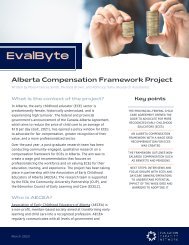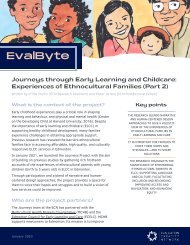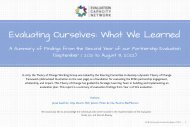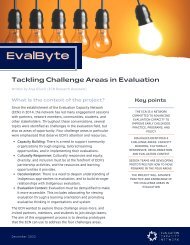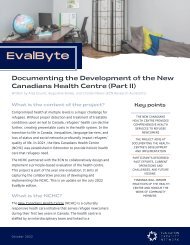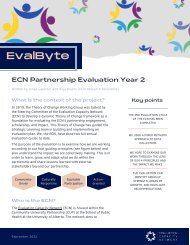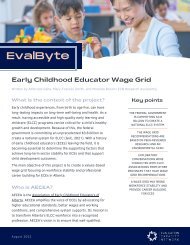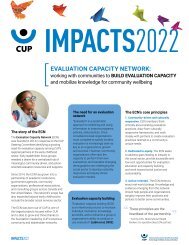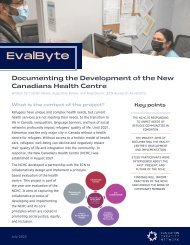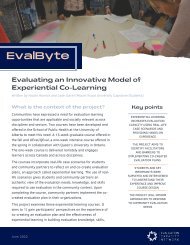CBE Workbook
Create successful ePaper yourself
Turn your PDF publications into a flip-book with our unique Google optimized e-Paper software.
order<br />
Evaluating<br />
Early<br />
Childhood<br />
Development<br />
Programs<br />
A WORKBOOK FOR EVALUATION<br />
CAPACITY-BUILDING<br />
~ 1 ~
THE FOUR PHASES OF COMMUNITY-BASED EVALUATION<br />
Did you forget what you learned in slide decks? Look for the<br />
throughout the workbook to be redirected to the appropriate slides.<br />
#<br />
This workbook accompanies the Evaluating Early Childhood Development Programs slide decks, which<br />
is part of a larger nation-wide initiative to build the evaluation capacity of the early childhood<br />
development sector across Canada. To learn more please visit: www.evaluationcapacitynetwork.com<br />
To evaluate your organization or group’s readiness for community-based evaluation, see Appendix F:<br />
Evaluation Capacity Readiness Tool.<br />
© 2021 Centre for Community Based Research<br />
Funded by<br />
~ 2 ~
PHASE 1 – Laying the Foundation<br />
Stakeholder Mapping<br />
Identify those who have a stake in the project and determine steering committee<br />
members.<br />
What groups of people have a stake in the issue that you wish to evaluate?<br />
Who could you invite to join a guiding steering committee that would bring these different<br />
stakeholder perspectives?<br />
SUSTAINERS<br />
INFLUENCERS<br />
PEOPLE WITH<br />
LIVED EXPERIENCE<br />
7-<br />
16<br />
Slide Deck #2<br />
~ 3 ~
Create a Logic Model<br />
Visualize your theory of change.<br />
Inputs<br />
Activities<br />
Outputs<br />
Immediate<br />
Outcomes<br />
Intermediate<br />
Outcomes<br />
Ultimate<br />
Outcomes<br />
Flow of people<br />
21-<br />
31<br />
Slide Deck #2<br />
~ 4 ~
Components of the Logic Model<br />
A logic model is an overview of the flow of materials and processes to<br />
produce the results desired by the organization or program.<br />
Inputs<br />
Resources such as staff, volunteers, resources, and<br />
funding<br />
Activities<br />
Program events or strategies (at the individual or<br />
community level) designed to achieve the outcomes<br />
Outputs<br />
Tangible results of the major activities (# of people<br />
trained, resources produced, etc.)<br />
Outcomes are the impacts on those people whom the organization<br />
wanted to benefit:<br />
a) changes in knowledge, understanding/perceptions, and actions<br />
b) enhancements in skills (needed to accomplish particular results)<br />
c) changes in conditions (increased financial security, confidence, etc.)<br />
.<br />
Immediate<br />
Outcomes<br />
Intermediate<br />
Outcomes<br />
Ultimate<br />
Outcomes<br />
Immediate changes as a result of activities<br />
(weeks/months)<br />
Changes in the mid-term (months/years)<br />
Long-term intended impact (years/decades)<br />
23<br />
Slide Deck #2<br />
~ 5 ~
Create a Purpose Statement<br />
What is the purpose of your evaluation?<br />
The<br />
purpose<br />
of this<br />
evaluation<br />
is to…<br />
VERB<br />
SCOPE, TARGET<br />
AUDIENCE AND FOCUS<br />
OF EVALUATION:<br />
INDICATES PROCESS<br />
AND OUTCOMES<br />
in order to…<br />
EXPLAIN THE<br />
ACTION OR USE OF<br />
THE EVALUATION<br />
Write your purpose statement below:<br />
For further details, see Appendix A: What Is Your Purpose for Evaluating?<br />
33-<br />
38<br />
Slide Deck #2<br />
~ 6 ~
PHASE 2 – Evaluation Planning<br />
Develop Your Main Questions<br />
What do you intend to understand with this evaluation?<br />
What are the 3-4 main questions that you want the evaluation to answer? How would<br />
answering these questions fulfill your evaluation’s purpose?<br />
7-<br />
11<br />
Slide Deck #3<br />
~ 7 ~
Decide On Your Methods<br />
What methods will you use to answer your main evaluation questions?<br />
What are the most effective and efficient ways to answer your evaluation questions (consider a<br />
mix of methods that provide: quantitative and qualitative data; primary and secondary data; data<br />
from different stakeholder perspectives)?<br />
How do your methods complement each other? How do they together better answer the main<br />
evaluation questions than if they were conducted alone?<br />
In what order (or stages) should the methods be carried out?<br />
For those methods requiring you to recruit participants, how will you select people to be<br />
involved (i.e., sampling) and how will you go about recruiting people (i.e., recruitment strategy)?<br />
For further details, see:<br />
✓ Appendix B: Methods for Collecting Information<br />
✓ Appendix C: Advantages and Challenges of Data Collection Methods<br />
✓ Appendix D: Data Collection Plan Worksheet<br />
13-<br />
18<br />
Slide Deck #3<br />
~ 8 ~
Develop Your Analysis Plan<br />
How would you go about analyzing your data? What strategies would you use for qualitative data? For quantitative data? How would<br />
you summarize across methods?<br />
20-<br />
22<br />
Slide Deck #3<br />
~ 9 ~
Program Evaluation Plan Worksheet<br />
Evaluation<br />
Component<br />
Stakeholder<br />
Mapping<br />
(see p. 3)<br />
Create a<br />
Logic Model<br />
(see pp. 4-5)<br />
Create a<br />
Purpose<br />
Statement<br />
(see page 6,<br />
Appendix A)<br />
Key Plan Information Actions Considerations Who Is<br />
Responsible?<br />
1. List of key<br />
stakeholder groups<br />
2. List of Steering<br />
Committee<br />
Members (and the<br />
groups they are<br />
representative of)<br />
3. Date/time of<br />
Orientation session<br />
4. List of evaluation<br />
expectations (based<br />
on consensus)<br />
5. Regular Steering<br />
Committee meeting<br />
dates/times<br />
1. Logic Model<br />
1. Purpose Statement<br />
Phase 1: Laying the Foundation<br />
Timeline<br />
23<br />
Slide Deck #5<br />
~ 10 ~
Evaluation<br />
Component<br />
Develop Your<br />
Main<br />
Evaluation<br />
Questions<br />
(see p. 7)<br />
Key Plan Information Actions Considerations Who Is<br />
Responsible?<br />
1. 3-4 Main Evaluation<br />
Questions<br />
2. Sub-questions, as<br />
appropriate<br />
Phase 2: Evaluation Planning<br />
Timeline<br />
Decide on<br />
Your<br />
Methods<br />
(see p. 8,<br />
Appendix B,<br />
C, D)<br />
1. Data collection<br />
method(s) for each<br />
of the main<br />
evaluation questions<br />
2. Sampling and<br />
recruitment<br />
strategies for each<br />
method<br />
Evaluation Method<br />
a.<br />
Sampling Strategies<br />
b.<br />
Recruitment Strategies<br />
c.<br />
Develop Your<br />
Data Analysis<br />
Plan<br />
(see p. 9,<br />
Qualitative<br />
Data Analysis<br />
ppt)<br />
1. Data Analysis Plan<br />
Phase 3: Information Gathering and Analysis<br />
23<br />
Slide Deck #5<br />
~ 11 ~
Evaluation<br />
Component<br />
Create a<br />
Sharing Plan<br />
(see pp. 13-<br />
14)<br />
Create an<br />
Action Plan<br />
(see p. 15)<br />
Key Plan Information Actions Considerations Who Is<br />
Responsible?<br />
1. Sharing / Knowledge<br />
Mobilization Plan<br />
1. Action Plan<br />
Phase 4: Acting on Findings<br />
Timeline<br />
For further details, see:<br />
✓ Appendix E: Program Evaluation Plan Worksheet with Questions and Prompts<br />
23<br />
Slide Deck #5<br />
~ 12 ~
PHASE 4 – Acting on Findings<br />
Create a Sharing Plan<br />
How will your group share learnings?<br />
What types of formats would best communicate your evaluation findings (e.g., reports,<br />
presentations, video, theatre, etc.)? Who is the intended audience(s) for each product?<br />
Target Audience<br />
Communication Format<br />
What are your dissemination strategies? What specific activities will help you share findings so<br />
that key people are moved into action? Are there any natural decision-making events that you<br />
can utilize?<br />
7-<br />
17<br />
Slide Deck #5<br />
~ 13 ~
Sharing What We Have Learned<br />
Your audience: __________________<br />
1. Messages 2. Goals 3. Strategies 4. Impact<br />
What are the key messages you<br />
want to share with your audience?<br />
What is the most important message<br />
your audience needs to know about<br />
how children are developing in your<br />
community? (Note: Create 3 key<br />
messages. Refer to the tree for<br />
ideas).<br />
1.<br />
What are the goals for each<br />
message?<br />
What goal(s) are you hoping to<br />
achieve by sharing the key message?<br />
What are your expectations?<br />
Messages<br />
What will be the most effective way<br />
to share this information with your<br />
audience?<br />
Consider the best way to<br />
communicate each of your key<br />
messages in order to reach your<br />
goals. There may be more than one<br />
idea per message.<br />
(Note: Go to the resource table for<br />
different ideas of how you could<br />
share this information with your<br />
audience).<br />
How will you know if you have<br />
achieved your goals?<br />
I will see indicators of……<br />
☐ Partnership/Collaboration (i.e.<br />
more collaboration between depts.,<br />
sharing of info across the<br />
community,)<br />
☐ Program or Service change (i.e.<br />
new or adapted programming,<br />
documented change in program<br />
outcomes)<br />
2.<br />
3.<br />
1.<br />
2.<br />
3.<br />
☐ Policy development or change<br />
☐ Knowledge Change (i.e.<br />
documented increase in awareness)<br />
☐ Attitude Change (i.e. documented<br />
increase in awareness)<br />
☐Other:<br />
Adapted from: Barwick, M. (2008, 2013). Knowledge Translation Planning Template. Ontario: The Hospital for Sick Children.<br />
7-<br />
17<br />
Slide Deck #5<br />
~ 14 ~
Create an Action Plan<br />
What are the potential steps that would be needed to start implementing the evaluation<br />
recommendations? How well are your steering committee and original partners positioned to<br />
do this? What new partners might you need to engage through your evaluation?<br />
What further information might be needed to provide more detailed implementation steps?<br />
19-<br />
21<br />
Slide Deck #5<br />
~ 15 ~
Appendix A: What Is Your Purpose for Evaluating?<br />
Purposes<br />
1. Judgement oriented Aimed at determining the overall merit, worth, significance or<br />
value (e.g., summative evaluation aimed at deciding if a program<br />
is sufficiently effective to be continued or replicated).<br />
2. Accountability Aimed at rendering account. Includes oversight and compliance,<br />
the assessment to the extent to which a program follows the<br />
directives, regulations, mandated standards, or other formal<br />
expectations (e.g., audits; accreditation). Driven by attention to<br />
external stakeholders.<br />
3. Improvement Improve programs (e.g., formative evaluation; continuous<br />
improvement; quality enhancement; manage more effectively).<br />
Generate knowledge (e.g., generalizations about effectiveness;<br />
theory building; scholarly publishing; policy making; extrapolate<br />
principles about what works).<br />
5. Monitoring Manage the program, routine reporting, early identification of<br />
problems. Provided information to those internal to the<br />
program (e.g., quality control, management information<br />
systems; routine reporting).<br />
6. Development Involves changing the intervention, adapting it to changed<br />
circumstances, and altering tactics based on complex, emergent<br />
and dynamic conditions (e.g., developmental evaluation; rapid<br />
assessment; rapid feedback; environmental scanning).<br />
Source: Patton, M.Q. (2012). Essentials of utilization-focused evaluation. Thousand Oaks: Sage Publications<br />
Our purposes often are more specific. Think about the program you are evaluating. Are you<br />
conducting evaluation in order to…<br />
✓ See if goals and objectives were met?<br />
✓ Determine outcomes for participants? Families? Groups/organizations? For the community?<br />
✓ Assess ultimate impact on the community in terms of changes in human, economic, civic, and/or<br />
environmental conditions?<br />
✓ Assess whether the program is worth the resources invested? To demonstrate accountability for<br />
resources invested? To determine resource allocations? To justify need for funding? To make sure<br />
resources aren’t wasted on ineffective programs?<br />
✓ Learn about what works/doesn’t work and for whom? Which activities lead to which outcomes?<br />
✓ Assess access and/or disparities in reach, participation, and outcomes?<br />
✓ Improve your service delivery or teaching? To help inform what you will do the next time?<br />
✓ Promote the program?<br />
✓ Meet the funder’s requirement?<br />
✓ Other?<br />
A special acknowledgement to: Javier Mignone, Summer Institute in Program Evaluation, The University of Manitoba<br />
oriented<br />
4. Knowledgegenerating<br />
33-<br />
38<br />
Slide Deck #2<br />
~ 16 ~
Appendix B: Methods for Collecting Information<br />
Survey: Collecting standardized information through structured questionnaires to generate<br />
quantitative data. Surveys may be mailed (surface and electronic), completed on site through<br />
interviews, either face-to-face or telephone.<br />
Case study: In-depth examination of a particular case (program, group of participants, single<br />
individual, site/location). Case studies use multiple sources of information and methods to provide as<br />
complete a picture as possible.<br />
Interviews: Information collected by talking with and listening to people, either face-to-face or over<br />
the telephone. Interviews range on a continuum for those which are tightly structures (as in a survey)<br />
to free flowing, conversational interviews.<br />
Observation: Collecting information through “seeing” and “listening.” Observations may be<br />
structured or unstructured.<br />
Group assessment: Use of group processes to collect evaluation information such as nominal group<br />
technique, focus group, Delphi, brainstorming and community forums.<br />
Expert or peer review: Examination by a review committee, panel of experts or peers.<br />
Portfolio reviews: Collection of materials, including samples of work, that encompass the breadth<br />
and scope of the program activity being evaluated.<br />
Testimonials: Individual statements by people indicating personal responses and reactions.<br />
Tests: Use of established standards to assess knowledge, skill, performance such as in pen-and-pencil<br />
tests or skills tests.<br />
Photographs, slides, videos: Use of photography to capture visual images<br />
Diaries, journals: Recording of events over time revealing the personal perspective of the<br />
writer/recorder<br />
Logs: Recording of chronological entries which are usually brief and factual.<br />
Document analysis: Use of content analysis and other techniques to analyze and summarize printed<br />
material and existing information.<br />
Other:<br />
Action cards: use of index cards on which participants record what they did – the “action” – and<br />
when they reached their goal; primarily used in self-assessment.<br />
Simulations: use of models or mock-ups to solicit perceptions and reactions.<br />
13-<br />
18<br />
Slide Deck #3<br />
~ 17 ~
Problem stories: narrative accounts of past, present or future situations as a means of identifying<br />
perceptions using fictional characters to externalize the problem situation.<br />
Creative expression: use of art forms to represent people’s ideas and feeling as through stories,<br />
drama, dance, music, art.<br />
Unobtrusive measures: the gathering of information without the knowledge of the people in the<br />
setting such as the wear and tear on a “planted” mat in front of a display.<br />
Source: Program Development and Evaluation, Methods for Collecting Information, Quick Tips #8, University of Wisconsin-<br />
Extension, Madison, WI. 2002<br />
A special acknowledgement to: Javier Mignone, Summer Institute in Program Evaluation, The University of Manitoba<br />
13-<br />
18<br />
Slide Deck #3<br />
~ 18 ~
Appendix C: Advantages and Challenges of Data Collection<br />
Methods<br />
Method Overall Purpose Advantages Challenges<br />
when need to quickly<br />
and/or easily get lots of<br />
information from people<br />
in a non-threatening way<br />
Questionnaires,<br />
surveys,<br />
checklists<br />
Interviews<br />
Documentation<br />
review<br />
Observation<br />
Focus groups<br />
Case studies<br />
when want to fully<br />
understand<br />
someone's impressions or<br />
experiences, or learn more<br />
about their answers to<br />
questionnaires<br />
when want impression of<br />
how program operates<br />
without interrupting the<br />
program; is from review<br />
of applications, finances,<br />
memos, minutes, etc.<br />
to gather accurate<br />
information about how a<br />
program actually operates,<br />
particularly about processes<br />
explore a topic in depth<br />
through group discussion,<br />
e.g., about reactions to an<br />
experience or suggestion,<br />
understanding common<br />
complaints, etc.; useful in<br />
evaluation and marketing<br />
to fully understand or<br />
depict client's experiences<br />
in a program, and conduct<br />
comprehensive examination<br />
through cross comparison<br />
-can complete anonymously<br />
-inexpensive to administer<br />
-easy to compare and analyze<br />
-administer to many people<br />
-can get lots of data<br />
-many sample questionnaires<br />
already exist<br />
-get full range and depth of<br />
information<br />
-develops relationship with<br />
client<br />
-can be flexible with client<br />
-get comprehensive and<br />
historical information<br />
-doesn't interrupt program<br />
or<br />
client's routine in program<br />
-information already exists<br />
-few biases about information<br />
-view operations of a<br />
program as they are actually<br />
occurring -can adapt to<br />
events as they occur<br />
-quickly and reliably get<br />
common impressions<br />
-can be efficient way to get<br />
much range and depth of<br />
information in short time<br />
-can convey key information<br />
about programs<br />
-fully depicts client's<br />
experience in program input,<br />
process, and results<br />
-powerful means to portray<br />
program to outsiders<br />
-might not get careful<br />
feedback<br />
-wording can bias client's<br />
responses<br />
-are impersonal<br />
-in surveys, may need<br />
sampling expert<br />
- doesn't get full story<br />
-can be hard to analyze and<br />
compare<br />
-can be costly<br />
-interviewer can bias client's<br />
responses<br />
-often takes much time<br />
-info may be incomplete<br />
-need to be quite clear<br />
about what looking for<br />
-not flexible means to get<br />
data; data restricted to what<br />
already exists<br />
-can be difficult to interpret<br />
seen behaviors<br />
-can be complex to<br />
categorize observations<br />
-can influence behaviors of<br />
program participants<br />
-can be expensive<br />
-can be hard to analyze<br />
responses<br />
-need good facilitator for<br />
safety and closure<br />
-difficult to schedule 6-8<br />
people together<br />
-usually quite time<br />
consuming to collect,<br />
organize, and describe<br />
-represents depth of<br />
information, rather than<br />
breadth<br />
of cases<br />
Source: McNamara, C. (1997-2008). Overview of methods to collect information. In Basic guide to program<br />
evaluation. Minneapolis, MN: Free Management Library.<br />
A special acknowledgement to: Javier Mignone, Summer Institute in Program Evaluation, The University of Manitoba<br />
13-<br />
18<br />
Slide Deck #3<br />
~ 19 ~
Appendix D: Data Collection Plan Worksheet<br />
Evaluation Question<br />
(What do you want to know?)<br />
To what extent has the program<br />
(8 months long) declined social<br />
isolation for children participating<br />
in different program activities?<br />
Indicator<br />
(How will you know it?)<br />
- level of engagement in<br />
different program activiites over<br />
time<br />
- level of engagement in other<br />
community activities over time<br />
- level of socializing with family<br />
members, friends, and<br />
classmates<br />
Stakeholder<br />
Perspective<br />
(Who will have this<br />
information?)<br />
- Parents/guardians<br />
- Program staff/volunteers<br />
- Friends and classmates<br />
- Program participants<br />
Data Collection Methods<br />
(How will you gather the<br />
information?)<br />
1. Parent/guardian interviews<br />
(sampled)<br />
2. Program staff/volunteer interviews<br />
or focus groups (sampled)<br />
3. Program staff/volunteer survey (all<br />
staff/volunteers)<br />
4. Participant focus groups<br />
(samples)<br />
5. Participant case study (sampled)<br />
Schedule<br />
(When will the information<br />
be collected?)<br />
1. Program entry, 4 & 8<br />
months thereafter<br />
2. Program entry, 4 & 8<br />
months thereafter<br />
3. Program entry and 8<br />
months thereafter<br />
4. Program entry and 8<br />
months thereafter<br />
5. At the end of the program<br />
13-<br />
18<br />
Slide Deck #3<br />
~ 20 ~
Appendix E: Program Evaluation Plan Worksheet with Questions and Prompts<br />
Evaluation<br />
Component<br />
Key Plan Information Actions Considerations Who Is<br />
Responsible?<br />
Phase 1: Laying the Foundation<br />
Timeline<br />
Stakeholder<br />
Mapping<br />
(see p. 3)<br />
6. List of key<br />
stakeholder groups<br />
7. List of Steering<br />
Committee<br />
Members (and the<br />
groups they are<br />
representative of)<br />
8. Date/time of<br />
Orientation session<br />
9. List of evaluation<br />
expectations (based<br />
on consensus)<br />
10. Regular Steering<br />
Committee meeting<br />
dates/times<br />
a. Identify program<br />
Stakeholders<br />
b. Choose a representative<br />
group of stakeholders to<br />
form a community-based<br />
evaluation Steering<br />
Committee<br />
c. Host an orientation to<br />
community-based evaluation<br />
for the Steering Committee<br />
d. Clarify expectations around<br />
the evaluation<br />
e. Incorporate the expertise<br />
each Steering Committee<br />
member in the development<br />
of the Evaluation Plan<br />
f. Ensure that the Steering<br />
Committee comes to<br />
consensus about the<br />
Evaluation Plan<br />
• Ensure that people<br />
with lived experience<br />
of the program topic(s)<br />
are well represented<br />
on the Steering<br />
Committee<br />
• Are there other<br />
important<br />
considerations (age,<br />
gender, home<br />
community, language,<br />
etc.?)<br />
• Agree on a regular<br />
meeting schedule early<br />
in the process to<br />
ensure Steering<br />
Committee member<br />
availability<br />
• Agree on the best<br />
methods of<br />
communication<br />
between meetings (ie.<br />
email updates)<br />
~ 21 ~<br />
23<br />
Slide Deck #5
Evaluation<br />
Component<br />
Key Plan Information Actions Considerations Who Is<br />
Responsible?<br />
Phase 1: Laying the Foundation<br />
Timeline<br />
Create a<br />
Logic Model<br />
(see pp. 4-5)<br />
2. Logic Model a. Identify program Inputs,<br />
Activities, Outputs and<br />
Outcomes (Immediate,<br />
Intermediate and Ultimate)<br />
• The Evaluating Refugee<br />
Programs Outcome<br />
Inventory includes key<br />
indicators for the<br />
refugee-serving sector<br />
Create a<br />
Purpose<br />
Statement<br />
(see page 6,<br />
Appendix A)<br />
2. Purpose Statement a. Develop the purpose<br />
statement for your<br />
community-based evaluation<br />
• Ensure that the<br />
purpose reflects the<br />
interests of all<br />
stakeholder groups<br />
(see: Appendix A)<br />
• The purpose statement<br />
should be clearly<br />
worded<br />
Phase 2: Evaluation Planning<br />
Develop Your<br />
Main<br />
Evaluation<br />
Questions<br />
(see p. 7)<br />
3. 3-4 Main Evaluation<br />
Questions<br />
4. Sub-questions, as<br />
appropriate<br />
a. Identify the 3-4 main<br />
questions you want the<br />
evaluation to answer.<br />
b. Be clear about how<br />
answering each question<br />
would help to fulfill the<br />
purpose of the evaluation.<br />
• If the 3-4 main<br />
evaluation questions<br />
are big picture<br />
questions, consider<br />
developing subquestions<br />
to which the<br />
evaluation can find<br />
concrete answers.<br />
~ 22 ~<br />
23<br />
Slide Deck #5
Evaluation<br />
Component<br />
Key Plan Information Actions Considerations Who Is<br />
Responsible?<br />
Phase 2: Evaluation Planning<br />
Timeline<br />
Decide on<br />
Your<br />
Methods<br />
(see p. 8,<br />
Appendix B,<br />
C, D)<br />
3. Data collection<br />
method(s) for each<br />
of the main<br />
evaluation questions<br />
4. Sampling and<br />
recruitment<br />
strategies for each<br />
method<br />
Evaluation Methods:<br />
d. Identify the most effective<br />
data collection methods for<br />
each of the 3-4 main<br />
evaluation questions<br />
e. Clarify how the methods<br />
compliment each other (ie.<br />
focus groups may explore<br />
themes of a survey in-depth)<br />
f. Plan the order of evaluation<br />
methods (ie. if focus groups<br />
will clarify themes arising<br />
from a survey, then the<br />
survey must happen first)<br />
Sampling<br />
g. Identify which stakeholder<br />
perspectives are needed to<br />
answer the main evaluation<br />
questions, and how you will<br />
include a sample of each<br />
relevant stakeholder group<br />
Recruitment<br />
h. Identify recruitment<br />
strategies for those<br />
stakeholder groups (ie.<br />
inviting known experts on a<br />
topic, choosing a random<br />
sample for a large group of<br />
potential participants, etc.)<br />
• Identify what<br />
information you<br />
already have or collect<br />
and how it helps to<br />
answer your main<br />
evaluation questions<br />
• Identify gaps between<br />
existing data and the<br />
data needed to answer<br />
your main evaluation<br />
questions so that you<br />
know what information<br />
you want to collect<br />
through the evaluation<br />
for each question<br />
~ 23 ~<br />
23<br />
Slide Deck #5
Evaluation<br />
Component<br />
Key Plan Information Actions Considerations Who Is<br />
Responsible?<br />
Phase 3: Information Gathering and Analysis<br />
Timeline<br />
Develop Your<br />
Data Analysis<br />
Plan<br />
(see p. 9,<br />
Qualitative<br />
Data Analysis<br />
ppt)<br />
2. Data Analysis Plan a. Review the 3-4 main<br />
evaluation questions<br />
b. Identify data analysis<br />
strategies for qualitative<br />
data, if applicable<br />
c. Identify data analysis<br />
strategies for quantitative<br />
data, if applicable<br />
d. Identify strategies for<br />
analyzing data across<br />
methods<br />
• Data analysis should<br />
answer the 3-4 main<br />
evaluation questions<br />
• What kind of data are<br />
you working with (# of<br />
surveys, transcripts,<br />
audio files, etc.)<br />
• What impact do you<br />
want the research to<br />
have on whom? (Who<br />
will read/use the<br />
research products,<br />
how, and what will<br />
they find persuasive?)<br />
• What resources do you<br />
have access to (ie.<br />
transcription is timeconsuming;<br />
be realistic)<br />
• Decide whether you<br />
will use deductive<br />
analysis (you<br />
determine the<br />
information you are<br />
looking for before<br />
reviewing the data),<br />
inductive analysis (key<br />
themes arise from the<br />
data gathered) or a<br />
balanced approach<br />
23<br />
Slide Deck #5<br />
~ 24 ~
Evaluation<br />
Component<br />
Key Plan Information Actions Considerations Who Is<br />
Responsible?<br />
Phase 4: Acting on Findings<br />
Timeline<br />
Create a<br />
Sharing Plan<br />
(see pp. 13-<br />
14)<br />
2. Sharing / Knowledge<br />
Mobilization Plan<br />
a. Identify each target audience<br />
for the research and the<br />
communication format /<br />
research product(s) you will<br />
create for that audience<br />
b. Identify key dissemination<br />
strategies or activities you<br />
will use to get those research<br />
products to the key target<br />
audiences<br />
• What are the key<br />
messages you want to<br />
share with each<br />
audience?<br />
• What are the goals for<br />
each message (ie. raise<br />
awareness, engender<br />
particular actions)?<br />
• What are the most<br />
effective ways to<br />
communicate each key<br />
message to reach your<br />
goals?<br />
• Are there local or<br />
national events or<br />
activities that would be<br />
strategic places to<br />
disseminate the<br />
research to particular<br />
audiences?<br />
• Are there websites,<br />
blogs, newsletters or<br />
other online spaces<br />
that will help you to<br />
reach one or more<br />
target audiences?<br />
• How will you know if<br />
you have reached your<br />
goals?<br />
~ 25 ~<br />
23<br />
Slide Deck #5
Evaluation<br />
Component<br />
Key Plan Information Actions Considerations Who Is<br />
Responsible?<br />
Phase 4: Acting on Findings<br />
Timeline<br />
Create an<br />
Action Plan<br />
(see p. 15)<br />
2. Action Plan a. Identify the actions that will<br />
need to be taken in order to<br />
begin and continue<br />
implementing the evaluation<br />
recommendations?<br />
• Which Steering<br />
Committee members<br />
are positioned to do<br />
what?<br />
• How can partners help<br />
and support?<br />
• What initial steps can<br />
you take based on the<br />
evaluation results and<br />
what further<br />
information do you<br />
need to gather before<br />
you can take additional<br />
steps?<br />
23<br />
Slide Deck #5<br />
~ 26 ~
Appendix F: Evaluation Capacity Readiness Tool<br />
Please rate your skill with the following:<br />
Not at all Skilled<br />
(1)<br />
(2) (3) (4)<br />
Very skilled<br />
(5)<br />
1. Developing an evaluation plan ( ) ( ) ( ) ( ) ( )<br />
2. Clearly stating measurable goals and objectives ( ) ( ) ( ) ( ) ( )<br />
3. Identifying strategies to collect information ( ) ( ) ( ) ( ) ( )<br />
4. Defining outcome indicators of my program ( ) ( ) ( ) ( ) ( )<br />
5. Deciding what questions to ask in an<br />
evaluation<br />
( ) ( ) ( ) ( ) ( )<br />
6. Deciding from whom to collect information ( ) ( ) ( ) ( ) ( )<br />
7. Collecting evaluation information ( ) ( ) ( ) ( ) ( )<br />
8. Analyzing evaluation information ( ) ( ) ( ) ( ) ( )<br />
9. Writing an evaluation report ( ) ( ) ( ) ( ) ( )<br />
10. Conducting an evaluation ( ) ( ) ( ) ( ) ( )<br />
25<br />
Slide Deck #1<br />
27
Please indicate how likely you are to do the following:<br />
Very unlikely (1) (2) (3) (4)<br />
Very likely<br />
(5)<br />
11. Use evaluation to determine the effectiveness of my<br />
organization<br />
( ) ( ) ( ) ( ) ( )<br />
12. Use evaluation findings to benefit my sponsor(s)/funder(s) ( ) ( ) ( ) ( ) ( )<br />
13. Use evaluation to improve transparency in my organization ( ) ( ) ( ) ( ) ( )<br />
14. Use evaluation to assess the effectiveness of activities my<br />
organization engages in<br />
( ) ( ) ( ) ( ) ( )<br />
15. Participate in evaluations as needed ( ) ( ) ( ) ( ) ( )<br />
16. Get staff members involved in evaluation ( ) ( ) ( ) ( ) ( )<br />
17. Oversee an external evaluator ( ) ( ) ( ) ( ) ( )<br />
18. Use evaluation findings in decision-making ( ) ( ) ( ) ( ) ( )<br />
19. Make organizational level changes based on evaluation<br />
findings<br />
20. Adopt new ideas in my day-to-day activities based on<br />
evaluation findings<br />
( ) ( ) ( ) ( ) ( )<br />
( ) ( ) ( ) ( ) ( )<br />
25<br />
Slide Deck #1<br />
28
Please indicate how often your organization/supervisor is likely to do the following:<br />
My organization/supervisor...<br />
Almost never (1) (2) (3) (4) Almost always (5)<br />
21. encourages staff to express their opinions. ( ) ( ) ( ) ( ) ( )<br />
22. involves staff when making long-term plans. ( ) ( ) ( ) ( ) ( )<br />
23. gives staff the opportunity to reflect on organizational<br />
goals.<br />
( ) ( ) ( ) ( ) ( )<br />
24. reviews mission, vision, and values with staff. ( ) ( ) ( ) ( ) ( )<br />
25. dedicates funds to conduct an evaluation. ( ) ( ) ( ) ( ) ( )<br />
26. allocates resources to undertake evaluation on an ongoing<br />
basis.<br />
( ) ( ) ( ) ( ) ( )<br />
27. builds ideas in collaboration with staff. ( ) ( ) ( ) ( ) ( )<br />
28. resolves inter-personal conflicts in a positive manner. ( ) ( ) ( ) ( ) ( )<br />
29. celebrates staff members' achievements. ( ) ( ) ( ) ( ) ( )<br />
30. promotes evaluative thinking. ( ) ( ) ( ) ( ) ( )<br />
25<br />
Slide Deck #1<br />
29
My organization/supervisor uses evaluation findings to...<br />
Almost never<br />
(1)<br />
(2) (3)<br />
(4)<br />
Almost always (5)<br />
31. report to a funder. ( ) ( ) ( ) ( ) ( )<br />
32. improve services or programs. ( ) ( ) ( ) ( ) ( )<br />
33. get additional funding. ( ) ( ) ( ) ( ) ( )<br />
34. design ongoing monitoring processes. ( ) ( ) ( ) ( ) ( )<br />
35. assess implementation of a program. ( ) ( ) ( ) ( ) ( )<br />
36. assess the quality of a program ( ) ( ) ( ) ( ) ( )<br />
37. improve outreach. ( ) ( ) ( ) ( ) ( )<br />
38. make informed decisions. ( ) ( ) ( ) ( ) ( )<br />
39. train staff. ( ) ( ) ( ) ( ) ( )<br />
40. develop promising practices. ( ) ( ) ( ) ( ) ( )<br />
How familiar are you with community-based evaluation?<br />
( ) Not familiar at all<br />
( ) Slightly familiar<br />
( ) Moderately familiar<br />
( ) Very familiar<br />
25<br />
Slide Deck #1<br />
30
Scoring Guide<br />
Overall Individual Capacity = Sum of question 1-20<br />
(Individual Evaluation skill = Sum of questions 1-10; Individual Evaluation behavior = Sum of questions 11-20)<br />
Overall score between 0 and 39 –Entry level individual evaluation capacity. You have limited knowledge of evaluation and limited experience<br />
with evaluation. You may require more substantial training and/or support to conduct evaluations.<br />
Overall score between 40 and 59 - Novice level individual evaluation capacity. You have emerging knowledge of evaluation and some<br />
experience with evaluation but could use training with evaluation to develop skills further before conducting evaluations.<br />
Overall score between 60 and 79 - Proficient level individual evaluation capacity. You have basic evaluation skills and a moderate amount of<br />
experience with evaluation. You can likely conduct effective evaluations with minimal support.<br />
Overall score between 80 and 100 - Mastery level individual evaluation capacity. You have extensive evaluation knowledge and/or experience<br />
and can conduct effective evaluations on your own and may even be able to provide evaluation support to others.<br />
Overall Organizational Capacity = Sum of questions 21-40<br />
(Organizational Environment = Sum of questions 21-30; Organizational Evaluation use = Sum of questions 31-40)<br />
Overall score between 0 and 39 - Entry level organizational capacity. Your organizational environment is not conducive to<br />
conducting evaluations and if evaluations are conducted, your organization is unlikely to use evaluation findings.<br />
Overall score between 40 and 59 - Novice level organizational capacity. Your organization has some limited organizational capacity<br />
for evaluation and some capacity to use evaluation findings; however, use of evaluation findings is inconsistent.<br />
Overall score between 60 and 79 - Proficient level organizational capacity. Your organizational environment is conducive to<br />
evaluations for the most part and some use of evaluation findings is apparent.<br />
Overall score between 80 and 100 - Mastery level organizational capacity. Your organizational environment is conducive to<br />
evaluations and organization consistently and effectively uses evaluation findings.<br />
25<br />
Slide Deck #1<br />
31




